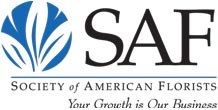Cure for the Summertime Blues
During the dog days of August, summer seems to drag on and on with little end in sight. While it is still going strong in most of the country, giving your customers a reason to by everyday flowers is sometimes a challenge. Perhaps a ‘Summer Time Blues’ feature of the week might help.
Blue pigment is still one of the most challenging colors for growers to produce naturally. Recently, some orchid growers have been using a pigment that is absorbed through the root system and therefore adds vibrant blue pigments to plants. One of the most popular has been the Phalenoposis Orchid Plants. While mostly presented at a mass market level or Big Box store, consumers have in fact embraced the color more often than the flower itself. A similar process is done on Roses whereby the stems are injected by hand with a syringe of dye to be absorbed into the vascular system. Breeders are currently close to cross breeding a true blue rose. This process of cross breeding takes many years and often decades to produce enough new flowers for production.
So in the mean time, consider a summer program that features natural blue flowers. Since a monochromatic (tints, tones, and shades) presentation can be very effective, consider using summer time favorites such as Hydrangea, Iris, Campanula, Belladonna Delphinium, Corn Flower, Eryngium, or Veronica. These flowers are all available during this growing season and work well with each other. They can be enhanced with complimentary foliage such as Dusty Miller or the gray-greens of the Eucalyptus family to continue the soft and summery feeling or contrasted with stronger green-white foliage such as variegated Ivy, variegated Pittosporum or Hosta foliage. All of these give your feature its own character and charm.
But not all your clients are going to embrace a monochromatic presentation. For those clients who want a little more variety, consider an analogous (three to five colors that adjoin or touch each other on the color wheel) color harmony. The above mentioned blue flowers could easily combine with the blue violets, red violets, and purples to expand the selection of components to be used. Stock, Larkspur, Roses, Chrysanthemums, and orchids might be but a few considerations for you to choose. The components that are placed together make for an exciting and fun exploration of color, shape, texture and size.
Placing oranges with your blue flowers gives you a complimentary (colors directly across from each other on the color wheel) color harmony. Think of nature’s way of showing the oranges and blues in combination with each other. The perfect example is the Bird of Paradise. The bright orange surrounds the center of the bird when it opens to show blue. There are lots of orange colored flowers such as Pincushion Protea, Roses, Gladiolus, Chrysanthemums, and Orchids. Remember to choose accent foliages that work well with these color harmonies. In this case, Croton foliage would be a great accent to emphasize the orange flowers.
While these are probably the most popular true color harmonies, don’t hesitate to combine blue flowers with yellows and accent with bright citric green for a real summer time feel. Delphinium, Sunflowers, and Bells of Ireland and a wonderful combination of colors and flowers that evoke a crisp, clean, sunny day that just brightens up a room!
This is a great way to use color to educate your customer on the psychological effects of color. Blues, violets and greens are what are known as cool colors. Think colors of the earth. They have a calming effect on people. By contrast, warm colors, those associated with fire, red, orange, and yellow, are intense colors that are visually invigorating.
With all these fun combinations of blue color harmonies to choose from, you and your customers will have fun exploring all the options for curing the summertime blues!


